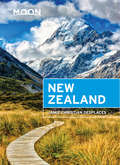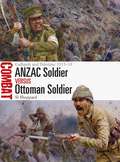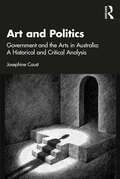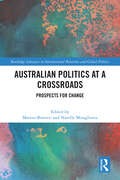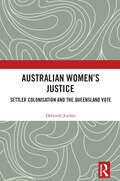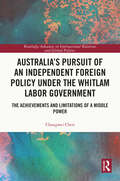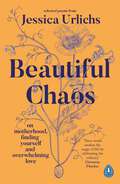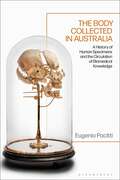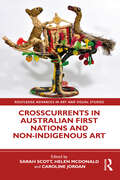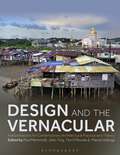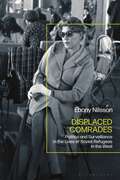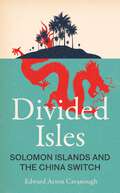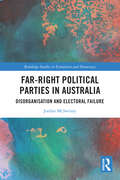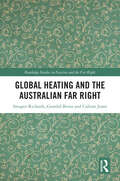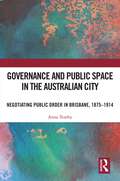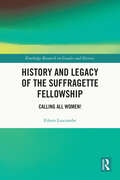- Table View
- List View
Moon New Zealand (Travel Guide)
by Jamie Christian DesplacesFrom green forests to blackened basalt, from snowy mountains to golden beaches, adventure awaits around every bend on these dramatic islands. Dive into Middle Earth with Moon New Zealand. Inside you'll find:Strategic itineraries including a week on both the North and South Islands, designed for hikers, cyclers, adrenaline junkies, history and culture buffs, and Lord of the Rings fansThe top spots for outdoor adventures, including surfing, bungy jumping, mountain biking, and trekking the Great Walks, as well as tips on how to do a New Zealand road tripThe top sights and unique experiences: Cruise the hypnotic black waters of the Milford Sound, spot wild dolphins, kiwis, and blue penguins, and explore the sprawling Waitomo Caves lit by twinkling glowworms. Go bungy jumping, paragliding, or jet skiing in Queensland, or soak in refreshing thermal pools. Embark on a multi-day trek to rugged coasts, glacial valleys, volcanoes, and fjords. Sample local sauvignon blancs in Marlborough and craft beers in Wellington, or sip cider in the Shire. Learn about Polynesian culture and history, marvel at Maori carvings, and savor a traditional hangiHow to experience New Zealand like an insider, support local and sustainable businesses, avoid crowds, and respectfully engage with the indigenous cultureExpert insight from Auckland local Jamie Christian Desplaces on when to go, how to get around, and where to stay Full-color photos and detailed maps throughout, plus a full-color detachable mapReliable background information on the landscape, climate, wildlife, and history, as well as common customs and etiquette Travel tips for seniors, families with children, visitors with disabilities, and LGBTQ travelersWith Moon New Zealand's expert advice and local insight, you can plan your trip your way.
ANZAC Soldier vs Ottoman Soldier: Gallipoli and Palestine 1915–18 (Combat)
by Si SheppardIn 1915–18, ANZAC and Ottoman soldiers clashed on numerous battlefields, from Gallipoli to Jerusalem. This illustrated study investigates the two sides' fighting men.The Gallipoli campaign of 1915–16 pitched the Australian and New Zealand volunteers known as the ANZACs into a series of desperate battles with the Ottoman soldiers defending their homeland. In August 1915, the bitter struggle for the high ground known as Chunuk Bair saw the peak change hands as the Allies sought to overcome the stalemate that set in following the landings in April. The ANZACs also played a key part in the battle of Lone Pine, intended to divert Ottoman attention away from the bid to seize Chunuk Bair. The Gallipoli campaign ended in Allied evacuation in the opening days of 1916. Thereafter, many ANZAC units remained in the Middle East and played a decisive role in the Allies' hard-fought advance through Palestine that finally forced the Turks to the peace table. The fateful battle of Beersheba in October 1917 pitted Australian mounted infantry against Ottoman foot soldiers as the Allies moved on Jerusalem. In this book, noted military historian Si Sheppard examines the fighting men on both sides who fought at Lone Pine, Chunuk Bair and Beersheba. The authoritative text is supported by specially commissioned artwork and mapping plus carefully chosen archive photographs.
Art and Politics: Government and the Arts in Australia: A Historical and Critical Analysis
by Josephine CaustAustralian governments at all levels have been engaged with arts and culture in many different forms since the beginning of European settlement. The way this has occurred is documented and analysed here, both from an historical and critical perspective. Changing understandings of culture and the significance of Indigenous Culture to Australia receive special attention. While the focus is primarily directed to Federal Government engagement, there is also consideration paid to both state and local government involvement. There is attention paid to the censorship of arts practice by governments as well as the direct interventions by politicians in arts practice. Different approaches to the arts by governments are also considered, as well as attempts to develop a national cultural policy. The impact of the recent pandemic is addressed and various research reports about the arts sector and its relationship with government are also noted. There is then a final discussion about some issues that governments could address in the future, that might ensure a more sustainable Australian arts sector. This book will be of particular interest to scholars of contemporary arts, arts management, cultural history, public policy and cultural policy. It may also interest bureaucrats and politicians.
Art and Politics: Government and the Arts in Australia: A Historical and Critical Analysis
by Josephine CaustAustralian governments at all levels have been engaged with arts and culture in many different forms since the beginning of European settlement. The way this has occurred is documented and analysed here, both from an historical and critical perspective. Changing understandings of culture and the significance of Indigenous Culture to Australia receive special attention. While the focus is primarily directed to Federal Government engagement, there is also consideration paid to both state and local government involvement. There is attention paid to the censorship of arts practice by governments as well as the direct interventions by politicians in arts practice. Different approaches to the arts by governments are also considered, as well as attempts to develop a national cultural policy. The impact of the recent pandemic is addressed and various research reports about the arts sector and its relationship with government are also noted. There is then a final discussion about some issues that governments could address in the future, that might ensure a more sustainable Australian arts sector. This book will be of particular interest to scholars of contemporary arts, arts management, cultural history, public policy and cultural policy. It may also interest bureaucrats and politicians.
Australian Politics at a Crossroads: Prospects for Change (ISSN)
As the 21st century proceeds apace, Australia faces new and old challenges, both domestically and internationally. These include managing complex governance issues, preventing democratic fracture, balancing an ever- shifting geopolitical strategic order, addressing the recognition and identity demands of marginalised groups, and responding to crises and urgent policy challenges, such as climate change.Bonotti, Miragliotta, and the other contributors to this volume analyse and evaluate the challenges which confront Australia by locating them in their national and comparative context. The various contributions reveal that while these challenges are neither novel nor unique to Australia, the way in which they manifest and Australia’s responses to them are shaped by the country’s distinctive history, culture, geography, location, and size.The chapters offer a cutting- edge analysis of these pressing challenges faced by Australia and offer reflections on how to address them. The book is a valuable resource for scholars and students of Australian politics, and of comparative politics in a global perspective.
Australian Politics at a Crossroads: Prospects for Change (ISSN)
by Matteo Bonotti Narelle MiragliottaAs the 21st century proceeds apace, Australia faces new and old challenges, both domestically and internationally. These include managing complex governance issues, preventing democratic fracture, balancing an ever- shifting geopolitical strategic order, addressing the recognition and identity demands of marginalised groups, and responding to crises and urgent policy challenges, such as climate change.Bonotti, Miragliotta, and the other contributors to this volume analyse and evaluate the challenges which confront Australia by locating them in their national and comparative context. The various contributions reveal that while these challenges are neither novel nor unique to Australia, the way in which they manifest and Australia’s responses to them are shaped by the country’s distinctive history, culture, geography, location, and size.The chapters offer a cutting- edge analysis of these pressing challenges faced by Australia and offer reflections on how to address them. The book is a valuable resource for scholars and students of Australian politics, and of comparative politics in a global perspective.
Australian Women's Justice: Settler Colonisation and the Queensland Vote
by Deborah JordanThis book explores how women spearheaded the democratic suffrage campaign in colonial Queensland engaging with international debates on women’s activism, leadership, advocacy, print culture, and social movements. Australian Women's Justice provides a nuanced reading of the diversity and differences of the women’s movement in Queensland, from the time of first white colonisation, federation to World War 1 by new research on key women’s organisations: notably the Women’s Equal Franchise Association and the Women’s Peace Army. Framed through the lives of women suffrage participants, including their encounters with First Nations women, it also looks beyond microhistory to explore broader themes of the intersection of race, gender, property, war, and empire in the colonial context. Campaigns for enfranchisement and property rights and against conscription connect this story with larger international movements for women and labour, and organisations such as the League of Nations. This book will be of interest to students and researchers of Australian feminism and suffragism, as well as historians of feminist, labour, and peace movements both in Australia and internationally.
Australian Women's Justice: Settler Colonisation and the Queensland Vote
by Deborah JordanThis book explores how women spearheaded the democratic suffrage campaign in colonial Queensland engaging with international debates on women’s activism, leadership, advocacy, print culture, and social movements. Australian Women's Justice provides a nuanced reading of the diversity and differences of the women’s movement in Queensland, from the time of first white colonisation, federation to World War 1 by new research on key women’s organisations: notably the Women’s Equal Franchise Association and the Women’s Peace Army. Framed through the lives of women suffrage participants, including their encounters with First Nations women, it also looks beyond microhistory to explore broader themes of the intersection of race, gender, property, war, and empire in the colonial context. Campaigns for enfranchisement and property rights and against conscription connect this story with larger international movements for women and labour, and organisations such as the League of Nations. This book will be of interest to students and researchers of Australian feminism and suffragism, as well as historians of feminist, labour, and peace movements both in Australia and internationally.
Australia’s Pursuit of an Independent Foreign Policy under the Whitlam Labor Government: The Achievements and Limitations of a Middle Power (Routledge Advances in International Relations and Global Politics)
by Changwei ChenThe election of the Whitlam-led Labor government in December 1972 ushered in fresh ideas and audacious initiatives in Australia’s foreign policy. Whitlam’s approach was shaped by a vision of taking Australia forward to its "rightful" and "independent" place in the future of the Asia Pacific region. Examining a series of episodes in Australia’s foreign relations under Whitlam, Chen pays attention to a broad range of hitherto insufficiently researched domestic and international issues in Australian’s foreign relations of the early 1970s. They range from immigration policy and the abolition of appeals from Australian Courts to the Privy Council to such major international issues as the Anglo-American base in Diego Garcia, French nuclear testing in the Pacific and the Five Power Agreement with respect to Malaysia and Singapore. Chen demonstrates how the pursuit of foreign policy independence repeatedly placed the Whitlam Government in a position wedged in between Australia’s traditional allies and the Third World; and how it navigated Australia’s national interests on a series of dilemma situations involving conflicting strategic interests between Australia and its traditional allies, and those between major powers and the non-aligned countries. The analysis presented in this book contributes to not only historical literature on the subject but also to the understanding of how a middle power, like Australia, can navigate intensifying great power rivalry. Essential reading for scholars of Australian foreign policy, as well as being an invaluable case study of Middle Power diplomacy in the Asia Pacific region.
Australia’s Pursuit of an Independent Foreign Policy under the Whitlam Labor Government: The Achievements and Limitations of a Middle Power (Routledge Advances in International Relations and Global Politics)
by Changwei ChenThe election of the Whitlam-led Labor government in December 1972 ushered in fresh ideas and audacious initiatives in Australia’s foreign policy. Whitlam’s approach was shaped by a vision of taking Australia forward to its "rightful" and "independent" place in the future of the Asia Pacific region. Examining a series of episodes in Australia’s foreign relations under Whitlam, Chen pays attention to a broad range of hitherto insufficiently researched domestic and international issues in Australian’s foreign relations of the early 1970s. They range from immigration policy and the abolition of appeals from Australian Courts to the Privy Council to such major international issues as the Anglo-American base in Diego Garcia, French nuclear testing in the Pacific and the Five Power Agreement with respect to Malaysia and Singapore. Chen demonstrates how the pursuit of foreign policy independence repeatedly placed the Whitlam Government in a position wedged in between Australia’s traditional allies and the Third World; and how it navigated Australia’s national interests on a series of dilemma situations involving conflicting strategic interests between Australia and its traditional allies, and those between major powers and the non-aligned countries. The analysis presented in this book contributes to not only historical literature on the subject but also to the understanding of how a middle power, like Australia, can navigate intensifying great power rivalry. Essential reading for scholars of Australian foreign policy, as well as being an invaluable case study of Middle Power diplomacy in the Asia Pacific region.
Beautiful Chaos: On Motherhood, Finding Yourself and Overwhelming Love
by Jessica UrlichsThe perfect gift for mums and mums-to-be this Mother’s Day'The words awaken the magic of life by celebrating the ordinary' - Giovanna Fletcher'Beautifully heartfelt, inspiringly poignant and therapeutically validating' - Anna Mathur Motherhood is messy and beautiful, and hard and humbling. We adore our children, and sometimes we miss ourselves. Beautiful Chaos is a collection of raw, honest poems about motherhood - capturing everything from pregnancy to school age. Upon becoming a mother, poet Jessica Urlichs was reminded that the everyday ordinary is extraordinary. Beautiful Chaos is a collection that chronicles it all - the highs, the lows, the confusion, the loss of identity, the becoming, and the brutal but beautiful ways our children hold up a mirrors to ourselves. This collection inspires vulnerability and will be a cathartic, healing read for anyone who needs it. These poems will remind you of a time gone by or ground you in the current moment. Either way, they will make you feel seen and comforted amid the beautiful chaos that is motherhood.
The Body Collected in Australia: A History of Human Specimens and the Circulation of Biomedical Knowledge
by Eugenia PacittiOffering insight into nineteenth- and early twentieth-century medical school dissecting rooms and anatomy museums, this book explores how collected human remains have shaped Western biomedical knowledge and attitudes towards the body. To explore the role Australia played in the narrative of Western medical development, Pacitti focuses on how and why Australian anatomists and medical students obtained human body parts. As medical knowledge circulated between Australia and Britain, the colony's physicians conformed to established specimen collecting practices and diverged from them to form a distinct medical identity. Interrogating how these literal and figurative bones of contention have left an indelible mark on the nation's medical profession, collecting institutions, and communities, Pacitti sheds new light on our understanding of Western medical networks and reveals the opportunities and challenges historic specimen collections pose in the present day.The Body Collected in Australia is a cultural history of collectors and collections that deepens our understanding of the ways the living have used the dead to comprehend the intricacies of the human body in illness and good health.
Crosscurrents in Australian First Nations and Non-Indigenous Art (Routledge Advances in Art and Visual Studies)
This edited collection examines art resulting from cross-cultural interactions between Australian First Nations and non-Indigenous people, from the British invasion to today. Focusing on themes of collaboration and dialogue, the book includes two conversations between First Nations and non-Indigenous authors and an historian’s self-reflexive account of mediating between traditional owners and an international art auction house to repatriate art. There are studies of ‘reverse appropriation‘ by early nineteenth-century Aboriginal carvers of tourist artefacts and the production of enigmatic toa. Cross-cultural dialogue is traced from the post-war period to ‘Aboriginalism’ in design and the First Nations fashion industry of today. Transculturation, conceptualism, and collaboration are contextualised in the 1980s, a pivotal decade for the growth of collaborative First Nations exhibitions. Within the current circumstances of political protest in photographic portraiture and against the mining of sacred Aboriginal land, Crosscurrents in Australian First Nations and Non-Indigenous Art testifies to the need for Australian institutions to collaborate with First Nations people more often and better. This book will appeal to students and scholars of art history, Indigenous anthropology, and museum and heritage studies.
Crosscurrents in Australian First Nations and Non-Indigenous Art (Routledge Advances in Art and Visual Studies)
by Sarah Scott Helen McDonald Caroline JordanThis edited collection examines art resulting from cross-cultural interactions between Australian First Nations and non-Indigenous people, from the British invasion to today. Focusing on themes of collaboration and dialogue, the book includes two conversations between First Nations and non-Indigenous authors and an historian’s self-reflexive account of mediating between traditional owners and an international art auction house to repatriate art. There are studies of ‘reverse appropriation‘ by early nineteenth-century Aboriginal carvers of tourist artefacts and the production of enigmatic toa. Cross-cultural dialogue is traced from the post-war period to ‘Aboriginalism’ in design and the First Nations fashion industry of today. Transculturation, conceptualism, and collaboration are contextualised in the 1980s, a pivotal decade for the growth of collaborative First Nations exhibitions. Within the current circumstances of political protest in photographic portraiture and against the mining of sacred Aboriginal land, Crosscurrents in Australian First Nations and Non-Indigenous Art testifies to the need for Australian institutions to collaborate with First Nations people more often and better. This book will appeal to students and scholars of art history, Indigenous anthropology, and museum and heritage studies.
Design and the Vernacular: Interpretations for Contemporary Architectural Practice and Theory
by Paul Memmott, John Ting, Tim O’Rourke and Marcel VellingaDesign and the Vernacular explores the intersection between vernacular architecture, local cultures, and modernity and globalization, focussing on the vast and diverse global region of Australasia and Oceania. The relevance and role of vernacular architecture in contemporary urban planning and architectural design are examined in the context of rapid political, economic, technological, social and environmental changes, including globalization, exchanges of people, finance, material culture, and digital technologies. Sixteen chapters by architects designers and theorists, including Indigenous writers, explore key questions about the agency of vernacular architecture in shaping contemporary building and design practice. These questions include: How have Indigenous and First Nations building traditions shaped modern building practices? What can the study of vernacular architecture contribute to debates about sustainable development? And how has vernacular architecture been used to argue for postcolonial modernisation and nation-building and what has been the effect on heritage and conservation? Such questions provide valuable case studies and lessons for architecture in other global regions -- and challenge assumptions about vernacular architecture being anachronistic and static, instead demonstrating how it can shape contemporary architecture, nation building and cultural identities.
Displaced Comrades: Politics and Surveillance in the Lives of Soviet Refugees in the West
by Ebony NilssonThis book explores the lives of left-wing Soviet refugees who fled the Cold War to settle in Australia, and uncovers how they adjusted to life under surveillance in the West. As Cold War tensions built in the postwar years, many of these refugees happily resettled in the West as model refugees, proof of capitalist countries' superiority. But for a few, this was not the case. Displaced Comrades provides an account of these Cold War misfits, those refugees who fled East for West, but remained left-wing or pro-Soviet. Drawing on interviews, government records and surveillance dossiers from multiple continents this book explores how these refugees' ideas took root in new ways. As these radical ideas drew suspicion from western intelligence these everyday lives were put under surveillance, shadowed by the persistent threat of espionage. With unprecented access to intelligence records, Nilsson focuses on how a number of these left-wing refugees adjusted to life in Australia, opening up a previously invisible segment of postwar migration history, and offering a new exploration of life as a Soviet 'enemy alien' in the West.
Divided Isles: Solomon Islands and the China Switch
by Edward Acton CavanoughIn 2019, Solomon Islands made international headlines when the country severed its decades-old alliance with Taiwan in exchange for a partnership with Beijing. The decision prompted international condemnation and terrified security experts, who feared Australia’s historical Pacific advantage would come unstuck.This development was framed as another example of China’s inevitable capture of the region – but this misrepresents how and why the decision was made, and how Solomon Islanders have skilfully leveraged global angst over China to achieve extraordinary gains. Despite Solomon Islands’ strategic importance, most outsiders know little about the country, a fragile island-nation stretching over a thousand islands and speaking seventy indigenous languages.In Divided Isles, Edward Cavanough explains how the switch played out on the ground and considers its extraordinary potential consequences. He speaks with the dissidents and politicians who shape Solomon Islands’ politics, and to the ordinary people whose lives have been upended by a decision that has changed the country – and the region – forever.
Divided Isles: Solomon Islands and the China Switch
by Edward Acton CavanoughIn 2019, Solomon Islands made international headlines when the country severed its decades-old alliance with Taiwan in exchange for a partnership with Beijing. The decision prompted international condemnation and terrified security experts, who feared Australia’s historical Pacific advantage would come unstuck.This development was framed as another example of China’s inevitable capture of the region – but this misrepresents how and why the decision was made, and how Solomon Islanders have skilfully leveraged global angst over China to achieve extraordinary gains. Despite Solomon Islands’ strategic importance, most outsiders know little about the country, a fragile island-nation stretching over a thousand islands and speaking seventy indigenous languages.In Divided Isles, Edward Cavanough explains how the switch played out on the ground and considers its extraordinary potential consequences. He speaks with the dissidents and politicians who shape Solomon Islands’ politics, and to the ordinary people whose lives have been upended by a decision that has changed the country – and the region – forever.
Far-Right Political Parties in Australia: Disorganisation and Electoral Failure (Routledge Studies in Extremism and Democracy)
by Jordan McSwineyThis book examines how Australian far-right parties organise and operate to better understand their limited electoral success. Australian far-right parties have yet to see results comparable to far-right parties in other contexts. Unlike many of their European counterparts that have made significant electoral gains up to and including participation in national governments, the Australian far-right parties of the ‘fourth wave’ have experienced relatively poor electoral results. But this does not necessarily mean that Australia is uniquely hostile to far-right politics. Focusing particularly on the 2019 Australian federal election, this book takes an organisational approach to better understand why Australian far-right parties struggle electorally. Through the novel lens of disorganised parties, the author argues that the failure to develop a functioning party organisation has resulted in Australian far-right parties being unable to effectively navigate their political environment. By focusing on disorganisation, this book provides a new perspective for understanding the limited electoral impact of the far right in Australia today, despite favourable conditions like normalised Islamophobia and growing dissatisfaction with mainstream parties. This book will be of interest to scholars and students of party politics, the far right, populism, and Australian politics.
Far-Right Political Parties in Australia: Disorganisation and Electoral Failure (Routledge Studies in Extremism and Democracy)
by Jordan McSwineyThis book examines how Australian far-right parties organise and operate to better understand their limited electoral success. Australian far-right parties have yet to see results comparable to far-right parties in other contexts. Unlike many of their European counterparts that have made significant electoral gains up to and including participation in national governments, the Australian far-right parties of the ‘fourth wave’ have experienced relatively poor electoral results. But this does not necessarily mean that Australia is uniquely hostile to far-right politics. Focusing particularly on the 2019 Australian federal election, this book takes an organisational approach to better understand why Australian far-right parties struggle electorally. Through the novel lens of disorganised parties, the author argues that the failure to develop a functioning party organisation has resulted in Australian far-right parties being unable to effectively navigate their political environment. By focusing on disorganisation, this book provides a new perspective for understanding the limited electoral impact of the far right in Australia today, despite favourable conditions like normalised Islamophobia and growing dissatisfaction with mainstream parties. This book will be of interest to scholars and students of party politics, the far right, populism, and Australian politics.
Global Heating and the Australian Far Right (Routledge Studies in Fascism and the Far Right)
by Imogen Richards Gearóid Brinn Callum JonesGlobal Heating and the Australian Far Right examines the environmental politics of far-right actors and movements in Australia, exploring their broader political context and responses to climate change. The book traces the development of far-right pseudo-environmentalism and territorial politics, from colonial genocide and Australian nationalism to extreme-right political violence. Through a critical analysis of news and social media, it reveals how denialist and resignatory attitudes towards climate change operate alongside extreme right accelerationism, in a wider Australian political context characterised by reactionary fossil fuel politics and neoliberal New Right climate change agendas. The authors scrutinise the manipulation of environmental politics by contemporary Australian far- and extreme-right actors in cross-national online media. They also assess the political-ideological context of the contemporary far right, addressing intergovernmental approaches to security threats connected to the far right and climate change, and the emergence of radical environmentalist traditions in ‘New Catastrophism’ literature. The conclusion synthesises key insights, analysing the mainstreaming of ethnonationalist and authoritarian responses to global heating, and potential future trajectories of far-right movements exploiting the climate crisis. It also emphasises the necessity for radical political alternatives to counter the far right’s exploitation of climate change. This book will be of interest to researchers of climate change, the far right, neoliberal capitalism, extremism and Australian politics.
Global Heating and the Australian Far Right (Routledge Studies in Fascism and the Far Right)
by Imogen Richards Gearóid Brinn Callum JonesGlobal Heating and the Australian Far Right examines the environmental politics of far-right actors and movements in Australia, exploring their broader political context and responses to climate change. The book traces the development of far-right pseudo-environmentalism and territorial politics, from colonial genocide and Australian nationalism to extreme-right political violence. Through a critical analysis of news and social media, it reveals how denialist and resignatory attitudes towards climate change operate alongside extreme right accelerationism, in a wider Australian political context characterised by reactionary fossil fuel politics and neoliberal New Right climate change agendas. The authors scrutinise the manipulation of environmental politics by contemporary Australian far- and extreme-right actors in cross-national online media. They also assess the political-ideological context of the contemporary far right, addressing intergovernmental approaches to security threats connected to the far right and climate change, and the emergence of radical environmentalist traditions in ‘New Catastrophism’ literature. The conclusion synthesises key insights, analysing the mainstreaming of ethnonationalist and authoritarian responses to global heating, and potential future trajectories of far-right movements exploiting the climate crisis. It also emphasises the necessity for radical political alternatives to counter the far right’s exploitation of climate change. This book will be of interest to researchers of climate change, the far right, neoliberal capitalism, extremism and Australian politics.
Governance and Public Space in the Australian City: Negotiating Public Order in Brisbane, 1875-1914
by Anna TembyGovernance and Public Space in the Australian City is a rich and evocative examination of the production and use of public spaces in Australian cities in the late-nineteenth and early-twentieth centuries. Using Brisbane as a case study, it demonstrates the way public spaces were constructed, contested, and controlled in attempts to create ‘ideal’ city spaces. This construction of space is considered not just in the literal and material sense but also as a product of aspirational and imaginative processes of city-building by municipal authorities and citizens. This book is as much about people as it is about cities – uncovering the manner in which perceived models of ideal urban citizenship were reflected in the production and ordering of city spaces. This book challenges common narratives that situate public spaces as universal or equalising aspects of the urban sphere. Exploring three distinct types of public space – the streets, slums, and parks – the book questions how urban spaces functioned, alongside how they were intended to function. In so doing, Governance and Public Space in the Australian City situates public spaces as products of manipulation and regulation at odds with broader concepts of individual liberty and the ‘rights’ of people to public space. It will be illuminating reading for scholars and students of urban history and Australian history.
Governance and Public Space in the Australian City: Negotiating Public Order in Brisbane, 1875-1914
by Anna TembyGovernance and Public Space in the Australian City is a rich and evocative examination of the production and use of public spaces in Australian cities in the late-nineteenth and early-twentieth centuries. Using Brisbane as a case study, it demonstrates the way public spaces were constructed, contested, and controlled in attempts to create ‘ideal’ city spaces. This construction of space is considered not just in the literal and material sense but also as a product of aspirational and imaginative processes of city-building by municipal authorities and citizens. This book is as much about people as it is about cities – uncovering the manner in which perceived models of ideal urban citizenship were reflected in the production and ordering of city spaces. This book challenges common narratives that situate public spaces as universal or equalising aspects of the urban sphere. Exploring three distinct types of public space – the streets, slums, and parks – the book questions how urban spaces functioned, alongside how they were intended to function. In so doing, Governance and Public Space in the Australian City situates public spaces as products of manipulation and regulation at odds with broader concepts of individual liberty and the ‘rights’ of people to public space. It will be illuminating reading for scholars and students of urban history and Australian history.
History and Legacy of the Suffragette Fellowship: Calling all Women! (Routledge Research in Gender and History)
by Eileen LuscombeHistory and Legacy of the Suffragette Fellowship provides a biographical account of the scope and depth of the memory work of the now-forgotten commemorative group the Suffragette Fellowship, active from the 1920s to the 1970s. The Suffragette Fellowship comprised members from the militant suffrage groups known as the Women’s Social and Political Union, the Women’s Freedom League, and the Actress Franchise League. This research provides a comprehensive analysis of the Fellowship’s attempts to form and sustain a collective Suffragette identity across four decades of activity. It considers the legacy of contested histories attached to militant campaigning that pressured Fellowship leaders to take control of the public memory of suffrage history. With close attention given to a neglected piece of feminist history, this book highlights the cultural and political impacts that the Fellowship enacted in their memory of the women’s suffrage movement. Richly illustrated with images of members, artefacts, and publications, this extensive study of the Suffragette Fellowship adds to transnational suffrage histories in the United Kingdom and Australia and will be of interest to scholars in memory studies and women’s history.
